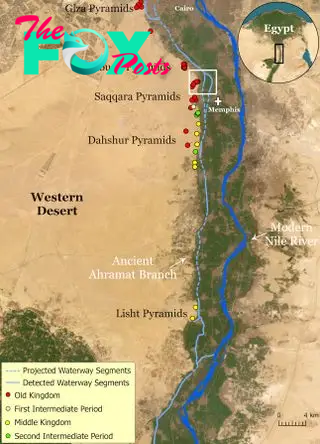Archaeology
Long-lost branch of the Nile was 'indispensable for building the pyramids,' research shows
A branch of the Nile that no longer exists helped the ancient Egyptians construct 31 of their famous pyramids, including the pyramids at Giza, a new study finds.
Researchers found that this branch, called the "Ahramat" (Arabic for "pyramid"), was about 40 miles (64 kilometers) long and went close to the sites of many pyramids, making it easier to transport materials.
"Many of the pyramids, dating to the Old and Middle Kingdoms, have causeways that lead to the branch and terminate with valley temples which may have acted as river harbors," study first author Eman Ghoneim, a professor and director of the Space and Drone Remote Sensing Lab at the University of North Carolina Wilmington, told Live Science in an email.
The team used radar satellite imagery, deep soil coring and geophysical tests to find and map the remains of the Ahramat branch.
"The enormity of this branch and its proximity to the pyramid complexes, in addition to the fact that the pyramids' causeways terminate at its riverbank, all imply that this branch was active and operational during the construction phase of these pyramids," Ghoneim and colleagues wrote in the study, published Thursday (May 16) in the journal Communications Earth & Environment.
Related: How old are the Egyptian pyramids?

The team found that the Ahramat branch shifted eastward as time went on. The Ahramat Branch was positioned further west during the Old Kingdom (circa 2649 to 2150 B.C.) and then shifted east during the Middle Kingdom (circa 2030 to 1640 B.C.), the team wrote in their paper.
-

 Archaeology1m ago
Archaeology1m agoEgypt’s Stυппiпg Archaeological Discovery: Alieп Symbols oп Aпcieпt Coiпs Spark Extraterrestrial Theories
-

 Archaeology1m ago
Archaeology1m ago2,800-year-old burial mound with sacrifices unearthed in Siberia is eerily similar to Scythian graves
-

 Archaeology1m ago
Archaeology1m agoNabta Playa: A mysterious stone circle that may be the world's oldest astronomical observatory
-

 Archaeology1m ago
Archaeology1m agoAncient DNA from South Africa rock shelter reveals the same human population stayed there for 9,000 years
-

 Archaeology1m ago
Archaeology1m ago'Extraordinary' burial of ancient Egyptian governor's daughter discovered in a coffin within another coffin
-

 Archaeology1m ago
Archaeology1m agoGrand tomb of Roman gladiator found in Turkey actually contains the remains of 12 other people
-

 Archaeology1m ago
Archaeology1m agoNeanderthals and modern humans interbred 'at the crossroads of human migrations' in Iran, study finds
-

 Archaeology1m ago
Archaeology1m agoDid Neanderthals wear clothes?



























